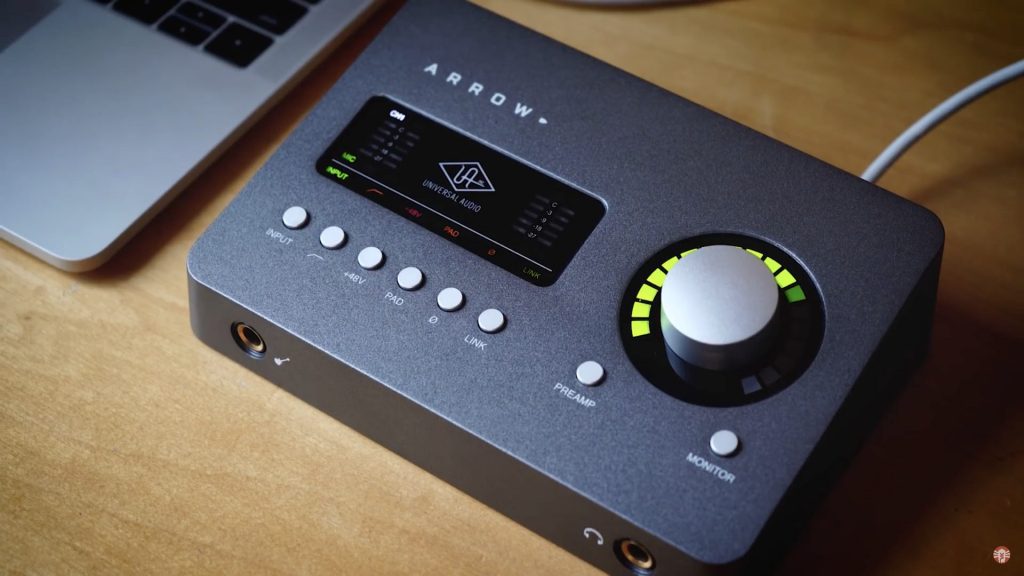Yes, It’s here, the first publicly available thunderbolt 3 equipped audio interface. Welcome the baby of the Universal Audio kingdom, The Arrow.
If you, like me in my geekdom, frequently troll the world of ProAudio forums, you will have seen several arguments about how pro audio interfaces do not actually need bandwidth in excess of what is available from USB 2. While this may be true, thunderbolt 3 is a whole new paradigm because of one primary reason – it’s capability to deliver power.
Universal Audio’s technology has resulted in arguably the most versatile audio interfaces on the market today. Their revolutionary unison technology preamp modelling enables you to emulate the sound of legendary analog gear with incredible accuracy. The Unison plug-in actually adjusts the preamp circuit itself, including parameters such as impedance, analog gain structure, and much more. When you adjust the Arrow‘s preamp gain knob and physical controls, the plug-in adjusts the preamp’s behavior to match the target preamp. So you’re not simply filtering your audio to approximate the character of a famous preamp — your microphone is now interacting with the Arrow‘s input the same way it would behave with the “modelled” preamplifier.
But this technology requires a massive amount of power, which has never before been deliverable over bus-power, so even their portable desktop interface, the Apollo Twin, needs an external power supply.
But with the Arrow, Universal audio opens the door to explore the phenomenal potential of the thunderbolt 3 format, which is now capable of providing enough power to build a bus-powered, truly portable interface, that comes with Unison technology.
I cannot contain my excitement for the possibilities this entails. This means I can be outdoors, in the most amazing locations, and record music on a console emulation of my choice, without having to worry about power sources, with best in class A/D-D/A conversion (by a mile).
The arrow comes in a nice-neat-small form factor, with a headphone output, a DI-line in, 2 Unison pre-amps, a pair of monitor outputs, a Solo Core for UA processing and comes included with the Analog classics plugin bundle . While a Solo core might not seem like much, it is enough to run the top of the line Unison enabled API or SSL console emulations, or a custom channel strip with your choice guitar amp, compression, EQ and reverb. Stage performers – vocalists or guitarists – pay attention – this vastly simplifies your rig. All this at an entry level price point.
There are some things to be aware of though, before you purchase one. You do need a thunderbolt 3 equipped computer, like the 2016-17 Touch bar MacBook Pros or some of the latest Razer windows laptops. Thunderbolt 3 will not work when connected to a thunderbolt 2 port of previous generation MacBook pros. While the thunderbolt 3 format uses the same connector as USB-C, a generic USB-C cable is not capable of delivering thunderbolt 3 protocol, an issue thats caused a lot of confusion in the market, which makes me wish UA had included a thunderbolt 3 cable in the box.
While UA essentially designed this interface for the entry level college musician, I truly believe they are going to see some strong demand from professional sound engineers, like me, who travel a lot and need to access UA plugins on the go. The thunderbolt format also means that the Arrow can be daisy chained, just like all other UA interfaces, so essentially, this can also function as the monitor controller for your rack mount UA Apollo interface (for which thunderbolt 3 option cards are now available, FYI).
The Arrow is for me, the coolest portable, future-proofed interface available on the market today. This is barely the beginning of the possibilities that thunderbolt 3 enables though, and I trust that not before long, we will see much more powerful interfaces from Universal audio, with several cores of UAD-2 processing available over bus power – the wet dream of the 21st century sound engineer.








